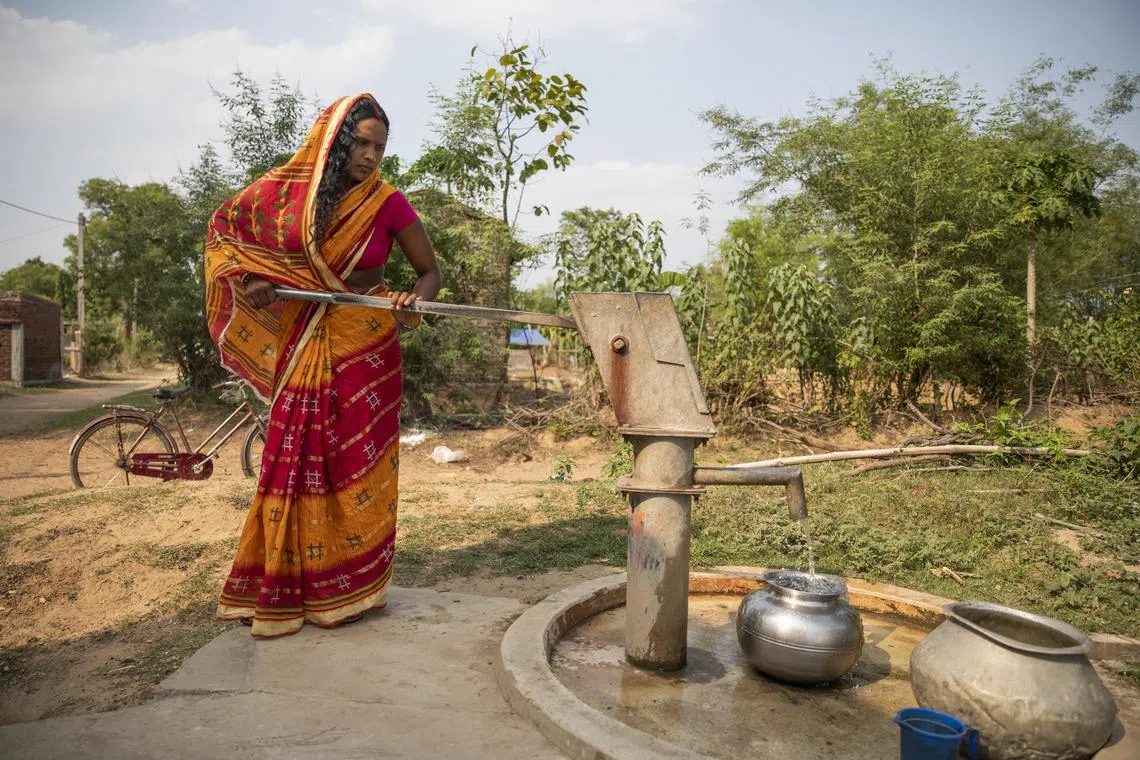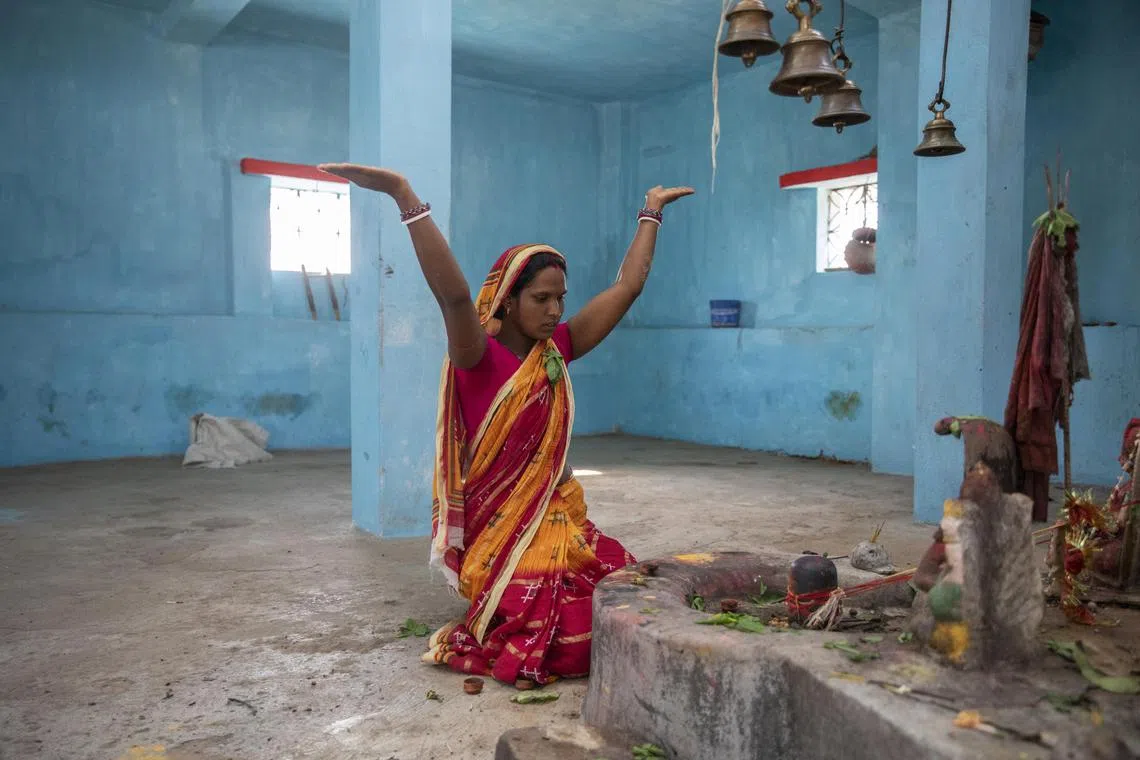India struggles to eradicate an old scourge: Witch hunting
Sign up now: Get ST's newsletters delivered to your inbox

Ms Durga Mahato was accused for being a witch and barred from using the community tap closest to her home in eastern Jharkhand, India.
PHOTO: NYTIMES
Follow topic:
TIRULDIH, India – They ushered the young woman into their home and closed the door behind her. Then the beating began.
“You are a witch,” shouted one of the attackers as she, her parents and her uncle rained punches, kicks and slaps on the 26-year-old woman’s stomach, chest and face.
When the pummelling finally ended, after nearly two hours, the young woman was pulled outside by her hair, dragged through her village and dumped, unconscious, next to a temple, her clothing barely clinging to her battered body.
The attack, in the eastern Indian state of Jharkhand in 2021, was evidence that India is still struggling to eradicate the age-old scourge of witch hunting, despite a raft of laws and other initiatives.
For centuries, the branding of witches was driven largely by superstition. A crop would fail, a well would run dry, or a family member would fall ill, and villagers would find someone – almost always a woman – to blame for a misfortune whose cause they did not understand.
Superstition has not gone away. But witchcraft accusations are now often simply a tool to oppress women, victims’ advocates say. The motives can be to grab land, to ostracise a woman to settle a score, or to justify violence.
In the Jharkhand case, the young woman who was attacked, Ms Durga Mahato, said the trouble started when she refused the sexual advances of a prominent man in the village.
He, his brother, his wife and their daughter then declared Ms Mahato a witch before luring her to their home and attacking her.
Ms Mahato; her husband Nirmal; and a local police officer described the assault, during which the prominent man threatened to rape her, she said.
All four attackers have been charged under anti-witch-hunt laws; the man and his brother are on bail after spending a few months in jail.
For Ms Mahato, the consequences of being labelled a witch did not end with the savage beating. She was banned from bathing in the village pond and drawing water from the community tap.
A wooden fence was built around her house to prevent her from wandering into the village. Villagers blame her for problems like the death of a cow. Only some people talk to her now. She still has pain in her waist and back.
“What wrong have I done, that God gave me such a huge punishment?” she said one recent evening, seated on a bright yellow charpoy, a woven bed, outside her brick house. “Call me a witch as much as you want to,” she added, breaking into tears.
“I have three young children. I dare not contemplate suicide,” she said.

Ms Chhutni Mahato, once a target of witch hunting, who has been recognised by the Indian government for her work in trying to eliminate the practice.
PHOTO: NYTIMES
Witch hunting still exists in varying measures across nearly a dozen Indian states, mostly in Indigenous tribal areas in central and eastern parts of the country, experts say.
Many states have passed laws against the practice. Some, such as Assam, have made penalties more stringent, with provisions of life imprisonment. Others, such as Odisha, have supplemented legal efforts by setting up memorials to victims at police stations in a bid to sensitise people.
Women branded witches have had their nails pulled out, been forced to eat faeces, been paraded naked or been beaten black and blue. They have been burned or lynched.
From 2010 to 2021, more than 1,500 people were killed in India after accusations of witchcraft, according to the National Crime Records Bureau.
Witch hunts are particularly common in Jharkhand, a mineral-rich yet poverty-riddled state where Indigenous tribes make up about one-quarter of the population.
The assault on Ms Mahato was one of 854 witchcraft-related cases recorded in the state in 2021, 32 of which resulted in deaths.
Jharkhand has taken a hands-on approach in trying to tackle the practice. A state-run programme called Project Garima has deployed about 25 “witch-hunting prevention campaign teams”, which conduct street plays to raise awareness.

Ms Durga Mahato in the temple near where she was dumped unconscious, after being beaten and accused of being a witch, in a village in the eastern state of Jharkhand, India.
PHOTO: NYTIMES
Village-level protection committees aid survivors of violence. Centres have been set up to provide legal aid and short-stay arrangements for victims. Workers staffing a help desk call survivors directly to get an update on their psychological and economic status.
But law enforcement can be weak.
Ms Madhu Mehra, the founder of a legal resource group for women, said that her organisation, in a study on witch hunting across three states, including Jharkhand, found that the police usually intervened only in cases of murder or attempted murder.
That and the difficulty of changing entrenched beliefs have helped allow the practice to persist, activists say.
While state officials had set 2023 as the target year for eradicating witch hunting, officials said they were now pushing back the goal by at least three years.
In Ms Durga Mahato’s case, the most helpful assistance came not from the government but from another witch-hunt victim, Ms Chhutni Mahato, who has been recognised by the Indian government for her work in trying to eliminate the practice.
Ms Durga Mahato’s aunt had heard about the work of Ms Chhutni Mahato (the two women are not related). Ms Durga Mahato found refuge for weeks in Ms Chhutni Mahato’s mud-and-tile-roofed home after spending two weeks in the hospital.
Ms Chhutni Mahato’s broken teeth are testimony to the torture she once bore at the hands of villagers who blamed her for a girl’s illness. She ran away and years later began working with a non-governmental organisation.
She often barges into police stations demanding action on witch-hunt cases and scolds village heads over the phone. Victims now reach her via word of mouth. She has helped more than 150 women in the state. NYTIMES

